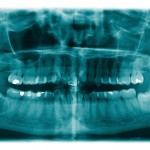
The extraction of impacted lower third molars is a very common surgical procedure and a range of periodontal problems may be encountered post-operatively. A range of regenerative periodontal treatments have been used to restore supporting tissues post-operatively, these include biological agents, guided tissue regeneration (GTR), osseous grafting and guided bone regeneration (GBR).
The aim of this review was to assess which regenerative techniques are most effective for preventing periodontal defects after extraction of the third molars
Methods
Searches were conducted in Medline, Cochrane library, Scopus, Web of science, ClinicalTrials.gov, OpenGrey, and the World Health Organisation’s International clinical trial registry platform databases. Randomised controlled trials (including split mouth designs) with more than 10 patients assessing safety’s safety and all efficacy of regenerative periodontal treatment following the lower third molar removal were considered.
Two reviewers independently selected studies, extracted data and assessed risk of bias using the Cochrane tool. Outcome measures were mean clinical attachment level (CAL) gain, mean probing depth (PD) reduction, mean alveolar bone level (ABL) gain, and adverse events. Odds ratios (OR) and 95% confidence intervals were used for dichotomous and outcomes and mean difference were used summarise data from each group meta-analysis was conducted when studies compare to similar techniques reported the same outcome measures.
Results
- 21 studies were included in the qualitative synthesis.
- 13 studies were considered to be at high risk of bias, 7 at low risk of bias and 1 at unclear risk.
- 18 studies involving a total of 567 patients (14 split mouth studies) contributed to a meta-analysis
- Compared with controls intervention groups were associated with
- Greater PD reduction, MD= 1.76 mm; (95% CI, 1.20 to 2.31 mm); P < .001; I2 = 90.2%)
- More significant ABL gain, MD= 1.21 mm; (95% CI, 0.21 to 2.21 mm); P = .018; I2 = 92.7%)
- Complications were reported in 39 out of 411 regenerative procedures a weighted mean complication rate of 7.5% (range 0 -35%).
Conclusions
The authors’ concluded: –
Regenerative periodontal therapy, in comparison with spontaneous healing of the wound, is effective early on in preventing the distal periodontal defect of the lower second molar after lower third molar extraction with regard to CAL gain, PD reduction, and ABL gain, without increasing the risk of postoperative complications.
Comments
The reviewers have followed a sound approach to this review searching a wide range of databases and restricting their inclusion criteria to randomised controlled trials. A good number of trials were identified although 62% of them were considered to be at high risk of bias. A board range of regenerative procedures were also available as a result there were limited numbers of studies comparing the same approaches. While the included studies suggested a benefit in terms of probing depth and alveolar bone level the findings should be viewed cautiously in light of the limited quality of the available studies.
Links
Primary Paper
Camps-Font O, Caro-Bonfill C, Sánchez-Garcés MÀ, Gay-Escoda C. Periodontal Regenerative Therapy for Preventing Bone Defects Distal to Mandibular Second Molars After Surgical Removal of Impacted Third Molars: A Systematic Review and Meta-Analysis of Randomized Clinical Trials. J Oral Maxillofac Surg. 2018 Jul 30. pii: S0278-2391(18)30846-2. doi:10.1016/j.joms.2018.07.025. [Epub ahead of print] Review. PubMed PMID: 30145192.
Original review protocol on PROSPERO
